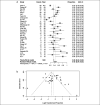Prevalence and Persistent Shedding of Fecal SARS-CoV-2 RNA in Patients With COVID-19 Infection: A Systematic Review and Meta-analysis
- PMID: 33835096
- PMCID: PMC8036078
- DOI: 10.14309/ctg.0000000000000343
Prevalence and Persistent Shedding of Fecal SARS-CoV-2 RNA in Patients With COVID-19 Infection: A Systematic Review and Meta-analysis
Abstract
Introduction: The prevalence and shedding of fecal severe acute respiratory syndrome coronavirus 2 (SARS-CoV-2) RNA indicate coronavirus disease 2019 (COVID-19) infection in the gastrointestinal (GI) tract and likely infectivity. We performed a systemic review and meta-analysis to evaluate the prevalence and the duration of shedding of fecal RNA in patients with COVID-19 infection.
Methods: PubMed, Embase, Web of Science, and Chinese databases Chinese National Knowledge Infrastructure and Wanfang Data up to June 2020 were searched for studies evaluating fecal SARS-CoV-2 RNA, including anal and rectal samples, in patients with confirmed COVID-19 infection. The pooled prevalence of fecal RNA in patients with detectable respiratory RNA was estimated. The days of shedding and days to loss of fecal and respiratory RNA from presentation were compared.
Results: Thirty-five studies (N = 1,636) met criteria. The pooled prevalence of fecal RNA in COVID-19 patients was 43% (95% confidence interval [CI] 34%-52%). Higher proportion of patients with GI symptoms (52.4% vs 25.9%, odds ratio = 2.4, 95% CI 1.2-4.7) compared with no GI symptoms, specifically diarrhea (51.6% vs 24.0%, odds ratio = 3.0, 95% CI 1.9-4.8), had detectable fecal RNA. After loss of respiratory RNA, 27% (95% CI 15%-44%) of the patients had persistent shedding of fecal RNA. Days of RNA shedding in the feces were longer than respiratory samples (21.8 vs 14.7 days, mean difference = 7.1 days, 95% CI 1.2-13.0). Furthermore, days to loss of fecal RNA lagged respiratory RNA by a mean of 4.8 days (95% CI 2.2-7.5).
Discussion: Fecal SARS-CoV-2 RNA is commonly detected in COVID-19 patients with a 3-fold increased risk with diarrhea. Shedding of fecal RNA lasted more than 3 weeks after presentation and a week after last detectable respiratory RNA.
Copyright © 2021 The Author(s). Published by Wolters Kluwer Health, Inc. on behalf of The American College of Gastroenterology.
Conflict of interest statement
Figures





References
-
- Coronavirus Disease (COVID-19): Weekly Epidemiological Update. World Health Organization: Geneva, Switzerland, 2020.
-
- Clinical Management of Severe Acute Respiratory Infection When Novel Coronavirus (2019-nCoV) Infection Is Suspected: Interim Guidance, 28 January 2020. World Health Organization: Geneva, Switzerland, 2020.
Publication types
MeSH terms
Substances
LinkOut - more resources
Full Text Sources
Other Literature Sources
Medical
Miscellaneous

